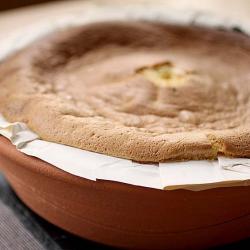 If there is a cake which evoques my childhood memories, Pão-de-Ló is the one at the top of my list. A glorious yet simple sponge cake, fluffy and light like a cloud and canary yellow. A traditional recipe of Conventual origins, a time of egg yolk surplus due to the high usage of whites in the daily errands of nuns and monks. A staple dessert for Christmas and Easter, delicious sliced and toasted, big wedges which resemble door stoppers. Served also, with a spoonful of sheep’s milk cheese, ripe and held together by a bandage of muslin only to travel to delis on the festive seasons. My grandmother used to sell them in the hundreds, all beautifully lined together with their faces up like big sunflowers which brought some warmth on cold December days. They had a special smell, the combination of the cartridge paper lining, the brown top and the fluffly inside which stuck to the paper, later to be scrapped by me with a spoon. On a recent trip to Portugal I have managed to find not only a version of the ancient recipe but also the terracota pots in which this cake is baked. And I made it in London. I am glad I have managed to exactly replicate this traditional recipe.
If there is a cake which evoques my childhood memories, Pão-de-Ló is the one at the top of my list. A glorious yet simple sponge cake, fluffy and light like a cloud and canary yellow. A traditional recipe of Conventual origins, a time of egg yolk surplus due to the high usage of whites in the daily errands of nuns and monks. A staple dessert for Christmas and Easter, delicious sliced and toasted, big wedges which resemble door stoppers. Served also, with a spoonful of sheep’s milk cheese, ripe and held together by a bandage of muslin only to travel to delis on the festive seasons. My grandmother used to sell them in the hundreds, all beautifully lined together with their faces up like big sunflowers which brought some warmth on cold December days. They had a special smell, the combination of the cartridge paper lining, the brown top and the fluffly inside which stuck to the paper, later to be scrapped by me with a spoon. On a recent trip to Portugal I have managed to find not only a version of the ancient recipe but also the terracota pots in which this cake is baked. And I made it in London. I am glad I have managed to exactly replicate this traditional recipe.
Ingredients
13 egg yolks (I know quite a lot but worth it)
2 egg whites
200 gr of sugar
pinch of salt
70 gr of plain flour
1 tsp of vanilla essence ( not necessary, a little touch by me)
Method
Pre-heat the oven at 200 ºC.
Traditionally the two terracota pots should be used for baking this cake, but a normal 23 cm diameter cake tin, lined with baking parchment will suffice.
In a bowl whisk the yolks with the whites, sugar and salt for 30 minutes. (This is very important, do not stop whisking for 30 minutes). After this time, the yolks would be super fluffy and light. Fold in the flour with a spatula and transfer to the cake spring form.
Bake for 30 minutes, remove from the oven and let it cool down before serve.
